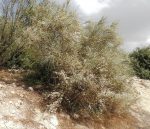 This dense deciduous flowering shrub is native to arid regions of northern Africa from the Western Sahara to Sudan, Sicily, the Sinai Peninsula, the Palestine region and Saudi Arabia. It belongs to the pea family, Fabaceae, that also includes lupines, black locust and mimosa. With a deep root, the shrub grows 10-20′ tall and has slender, green, drooping branches carrying .2″ long gray-green leaves that quickly fall so that photosynthesis is carried out primarily by the green stems. From late winter to early spring dense racemes of 3-15 fragrant, white flowers appear close to the stem. Each flowers is 1″ across and has banner, wing, and keel petals typical of the family. The seed pod is indehiscent, and contain one or two seeds. Photo Credit Peter Coxhead Wikipedia.
This dense deciduous flowering shrub is native to arid regions of northern Africa from the Western Sahara to Sudan, Sicily, the Sinai Peninsula, the Palestine region and Saudi Arabia. It belongs to the pea family, Fabaceae, that also includes lupines, black locust and mimosa. With a deep root, the shrub grows 10-20′ tall and has slender, green, drooping branches carrying .2″ long gray-green leaves that quickly fall so that photosynthesis is carried out primarily by the green stems. From late winter to early spring dense racemes of 3-15 fragrant, white flowers appear close to the stem. Each flowers is 1″ across and has banner, wing, and keel petals typical of the family. The seed pod is indehiscent, and contain one or two seeds. Photo Credit Peter Coxhead Wikipedia.
The Hebrew words rotem, rothem, r’tamin, or ritmah are ususally translated as broom, sometimes as juniper, but scholars believe that the plant is actually white weeping broom which is common in the Palestinian desert regions where it grows on hills, in rocky places, ravines, and sandy areas. It is also common around the Dead Sea, on Mount Carmel, and the Philistine and Phoenician coasts, and in Gilaead, the Jordan valley, Lebanon, and the deserts of Syria, Sinai, Egypt and Arabia Petraea. Weeping white broom was often the only plant in the deserts that provided shade. The phrase “coals of junipers” refers to the fact that the roots of white weeping broom are especially esteemed for making charcoal.
I Kings 19:4-5 (NKJV) Elijah flees into the wilderness after Jezebel threatens him.
4. “But he himself went a day’s journey into the wilderness, and came and sat down under a broom tree. And he prayed that he might die, and said, “It is enough! Now, LORD, take my life, for I am no better than my fathers!”
5. “Then as he lay and slept under a broom tree, suddenly an angel touched him, and said to him, “Ariseandeat.”’
Psalms 120:4 (NKJV) The psalmist describes the most fitting punishment for liars.
“Sharp arrows of the warrior, With coals of the broom tree!”
Weeping white broom likes full sun and sandy, lean, dry, well-drained soil in USDA Hardiness Zones 9-10 and is resistant to deer, heat, and drought but should be proteced from rain in winter. Propagation is by seed. It is grown as an ornamental in Mediterranean climates and is harvested from the wild for local use as medicine and a source of fuel. It is especially valued for making charcoal. Fruits and flowers provide forage for goats.
The genus name, Retama, is the Latinized form of the Arabic name for the plant, and refers to a string tied around a finger as a reminder. The specific epithet, raetam, is derived from Hebrew רְתֹם (retom) meaning “to bind”.